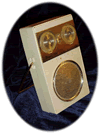

|
The Transistor Era
In 1947,
the transistor was invented at Bell Laboratories (now
Lucent Technologies).
Like the vacuum tube, the transistor could be used to amplify a signal.
Thus, small transistor radios (like the radios you see in old TV shows) soon replaced the old large, tube-based radios associated
with the Golden Age of Radio.
But the transistor was also capable of replacing the function of the vacuum tube as an electronic switch. And, in the computer industry as well, replacing vacuum tubes with transistors made computers smaller, less hot, and less expensive. This also enabled computers to become more powerful: with vacuum tubes, engineers were running into spatial limits; with transistors, however, many more circuits (and, thus, far more computing power) could be put inside a computer. Without this development, countless technologies would have been impossible; for example, the onboard computers required for space travel in the 1960s would not have fit onboard!
Over the course of the 1960s and 1970s, transistors became smaller and smaller. Many of the large mainframe computers that had been required to meet the computer needs of a large company were replaced by minicomputers ("mini-" having become a pop culture prefix of the 1960s—e.g., "miniskirt"). Thus, even smaller companies and institutions who formerly had to share and rent time on a mainframe computer (a phenomenon known as timesharing) now could afford their own computers! Eckert and Mauchlay had been right: there really was a market for computers!
Today, transistors are microscopic: millions of transistors can be put in a silicon chip the size of a postage stamp!

Image courtesy of
Lucent Technologies.
![]()
![]()
These pages were written by Steven H. VanderLeest and Jeffrey Nyhoff and edited by Nancy Zylstra
©2005 Calvin University (formerly Calvin College), All Rights Reserved
If you encounter technical errors, contact computing@calvin.edu.